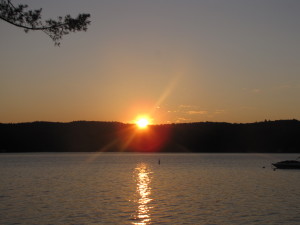Lakefront Property Owners Should Check with Town CEO Before Cutting or Pruning Trees
Spend an Old-Fashioned Summer at a Classic Maine Camp on Long Lake, Naples, Maine
September 5, 2013Out and About for the Bangor Lakes Region of Maine Sept. 12-18
September 11, 2013Lakefront Property Owners Should Check with Town CEO Before Cutting or Pruning Trees
Sunrise over Long Lake, Naples, Maine
On any given summer day from the porch of your Maine lakefront property, you hear the cry of a loon, watch the dragonflies hover over the water and enjoy the view as the kids swim. Well, you enjoy the bit of view that you have. It would be better, if only . . . you cut or limbed those trees by the water’s edge.
Caution!
Think before you act. Since 1973, shoreland zoning standards in Maine have restricted vegetation clearing. An adequate vegetated buffer between your camp or cottage and the shoreline protects the water quality, wildlife habitat and the character of Maine that we love.
Just how much can trees do to help? According to the American Forests organization, a healthy tree canopy can tremendously reduce stormwater runoff. “Leaves and branches intercept rainfall, reducing their erosive energy and slowing the movement of rain water. Root growth and plant litter improve soil structure and enhance infiltration of rainfall, reducing surface runoff. Stiff stems of trees and shrubs resist and slow the flow. Plant debris protects exposed soil and roots bind soil particles to resist erosion and stabilize slopes.
Trees provide shade that reduces water temperature and, more importantly, prevents large and sudden temperature fluctuations. Large tree debris creates habitat structure and smaller detritus contributes to the aquatic food chain. Trees infiltrate runoff resulting in contaminant filtering and the gradual release of groundwater into the lake or pond.” Even dead trees provide valuable wildlife habitat and nesting opportunities.
OK, you think, so I can’t remove the trees, but may I prune them? Yes, pruning of branches on the bottom 1/3 is permitted. We do suggest, however, that you consult with your local code enforcement officer before you do this or any clearing of vegetation within the shoreland zone. Recently in the town of Raymond, both the contractor and the property owner paid substantial fines for trees that were over-pruned. Though using a licensed arborist should be a defense against this happening, it can occur–and did. Lesson learned–check with your town’s CEO and the Maine DEP. They’ll be happy to evaluate your situation and make suggestions so that as lakefront property owners, you are complying with the standards.
Here are the general rules:
• On great ponds and rivers flowing into them, there is a 100 foot buffer zone.
• No more than 40% of the total volume of trees over 4 inches in diameter may be harvested in any 10 year period.
• Vegetation less than 3 feet in height, including ground cover, cannot be removed.
• Pruning the lower 1/3 of tree branches within the buffer is permitted.
• On all other water bodies the buffer zone is 75 feet and clearing is limited to 40% of volume in a 10 year period and no cleared openings. Also within these buffer zones:
• No opening within the forest canopy can exceed 250 square feet.
• A winding footpath is allowed, its width depending on the body of water.
• Selective cutting is allowed according to an established rating system.
• Clearing beyond the buffer zones and timber harvesting is also regulated. See the local ordinances.
To view lakefront properties for sale on Long Lake in Naples, click on the green box above.
To learn more about the Sebago Lakes Region of Maine, check out the blog links below.
Hikes In and Around Sebago Lake, Maine
Naples Hosts the Annual Maine Blues Fest Beside Long Lake and Brandy Pond
Spend an Old-Fashioned Summer at a Classic Maine Camp on Long Lake, Naples, Maine

